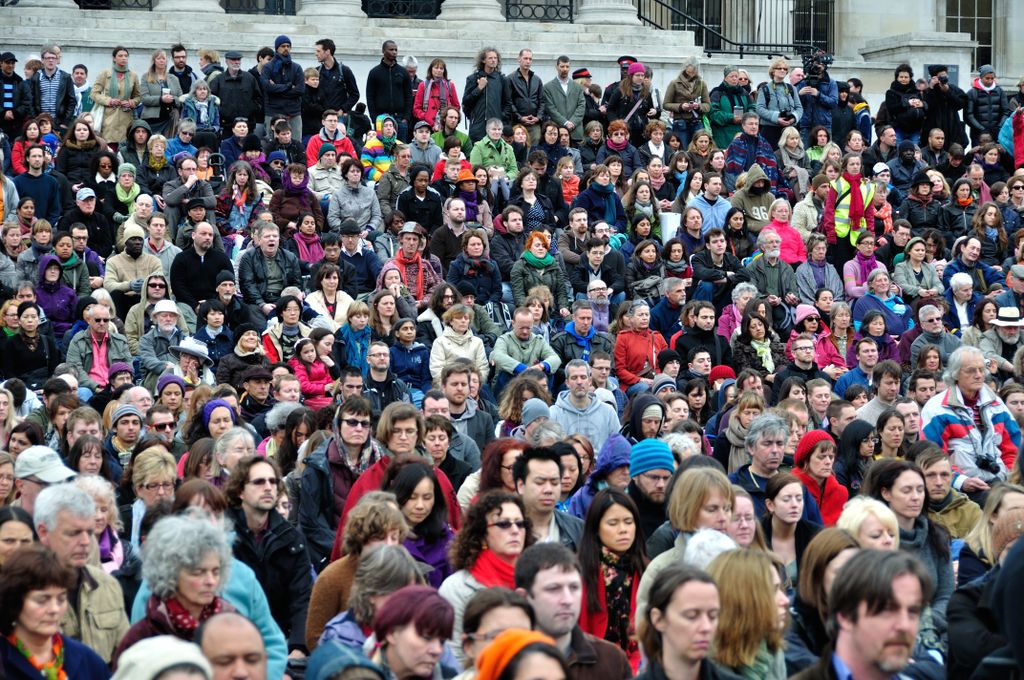By Brother Phap Lai
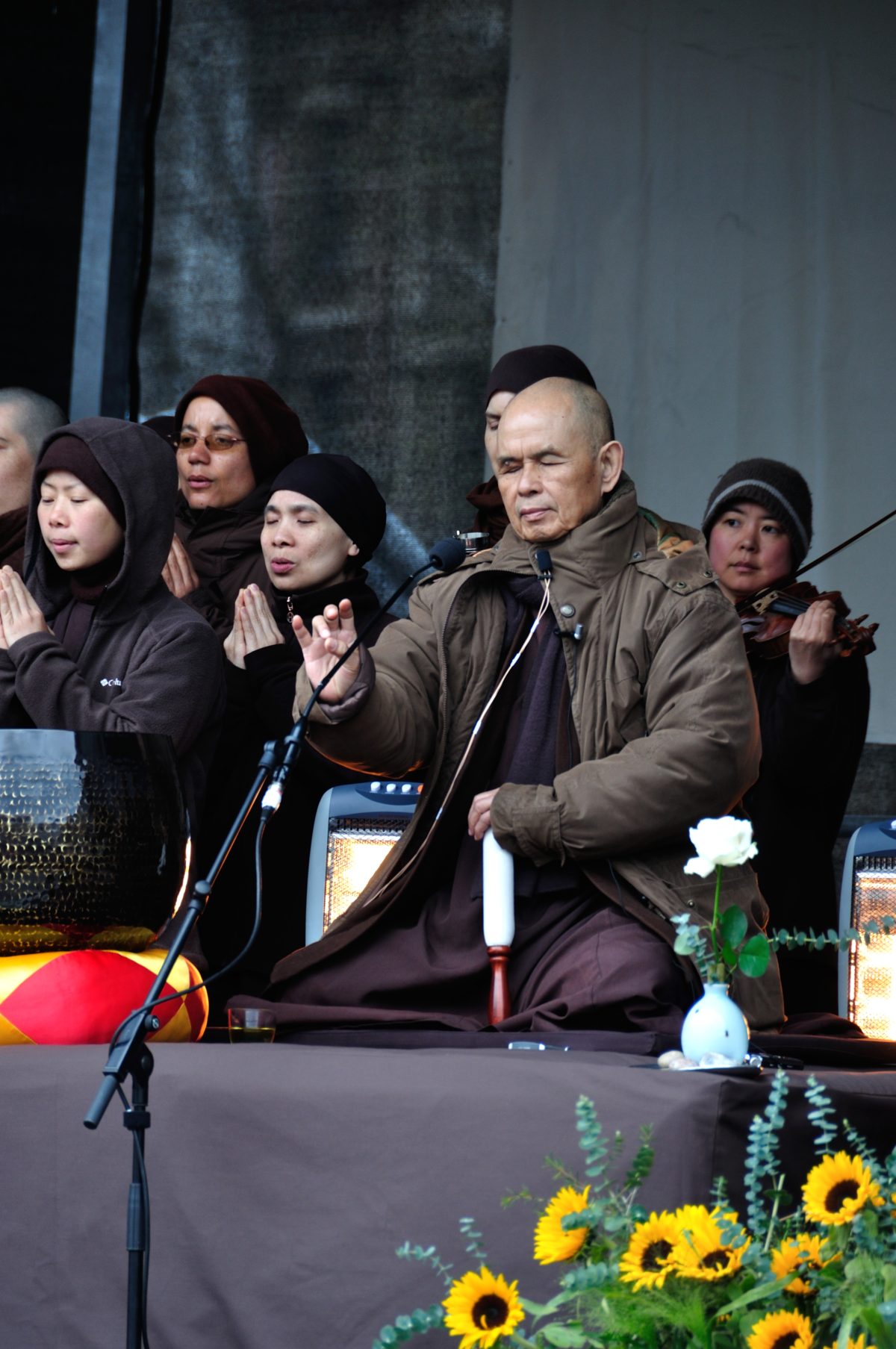
London’s Trafalgar Square has long been the site of noisy political protests, rallies, and events such as a glamorous promotion for the latest Harry Potter film. Yet on a blustery, cold day in early spring 2012, it was transformed into a meditation hall by the capital’s young people. The entire square was filled with four thousand people who had come together with no purpose other than to “Sit in Peace.” It was a landmark moment in London’s history,
By Brother Phap Lai

London’s Trafalgar Square has long been the site of noisy political protests, rallies, and events such as a glamorous promotion for the latest Harry Potter film. Yet on a blustery, cold day in early spring 2012, it was transformed into a meditation hall by the capital’s young people. The entire square was filled with four thousand people who had come together with no purpose other than to “Sit in Peace.” It was a landmark moment in London’s history, a silent and loving revolution. Thanks to Thay’s presence, people gathered and generated an immense energy of concentration and peace.
Like the peace walks that Thay has led in many countries, the “Sit in Peace” event was free and open to the public without restrictions on numbers, yet it required a lot of planning, communication, and cooperation among many groups. The Wake Up London Sangha was invited to take the lead in organising the event—its first effort to organise something on a national scale. Much support and financial backing came from The Community of Interbeing UK.
Beginnings
When Sister Hien Nghiem, Brother Phap Linh, and I first sat down to talk about Thay’s 2012 United Kingdom tour, we clearly envisaged a peace walk in London and also saw the possibility of a flash mob* meditation in Trafalgar Square, organised through Wake Up London. We imagined Thay could offer some words during the sitting and then explain the practice of walking meditation. The Sangha would walk mindfully to St. James’s Park, a short distance from the square, and practice walking meditation in the park. Wake Up London responded very well to these ideas and immediately got to work, applying for permissions from the London City Council and putting together teams for organising, stewarding, stage and sound production, publicity, and so on.
Members of the core team attended Wake Up Sangha’s mindfulness afternoons every fortnight because we wanted the “Sit in Peace” event, in all its various stages of planning and realisation, to be rooted in the practice. Things were going well until, shortly before the date of the event, The Royal Parks withdrew its permission for us to use park space for walking when they realised we would number in the thousands, not hundreds. Permission to cross the roads also became an issue. Knowing how much Thay likes to have a peace walk, we explored all alternative walking routes leading from Trafalgar Square and even carefully crafted a personal appeal to the Lord Mayor of London. At a certain point, with no word from the Lord Mayor’s office, we asked permission from Thay to abandon the idea of a peace walk and to focus all our energies on Trafalgar Square to make “Sit in Peace” a beautiful event.
Energy of Brotherhood and Sisterhood
“Sit in Peace” was scheduled for March 31, 2012, one week into Thay’s “Cooling the Flames” Tour of the United Kingdom and Ireland. The day dawned cloudy, with the threat of rain. Gusts of wind tore through the streets and through Trafalgar Square, chilling everyone who was outside. Elina Pen, co-organiser of the event and one of Wake Up London’s first members, recalls the day:
“I woke up very excited, having had only four hours of sleep because I was up late with some final organisational things. Two of us arrived in Trafalgar Square at 7:00 a.m. to oversee the setting up of the stage and sound system, and slowly some photographers, filmmakers, and stewards began to arrive.
“We had printed two thousand ‘Sit in Peace’ cards, containing information about sitting meditation and Avalokiteshvara and what invoking her name means. As we handed out the cards, everyone was so appreciative to receive one—there was a beautiful energy of fellowship and of brotherhood and sisterhood. There were many familiar faces from the community we had been building up over the previous months, and it was a real challenge to greet and connect with everyone while also taking care of everything that needed to be done. We had a deadline of putting away the heavy fences around Nelson’s Column by 4:00 p.m., which was really worrying! But there was such a feeling of awe, seeing all the people there, and realising that everything is in place, what needs to be done has been done, and everything is happening as it should.”
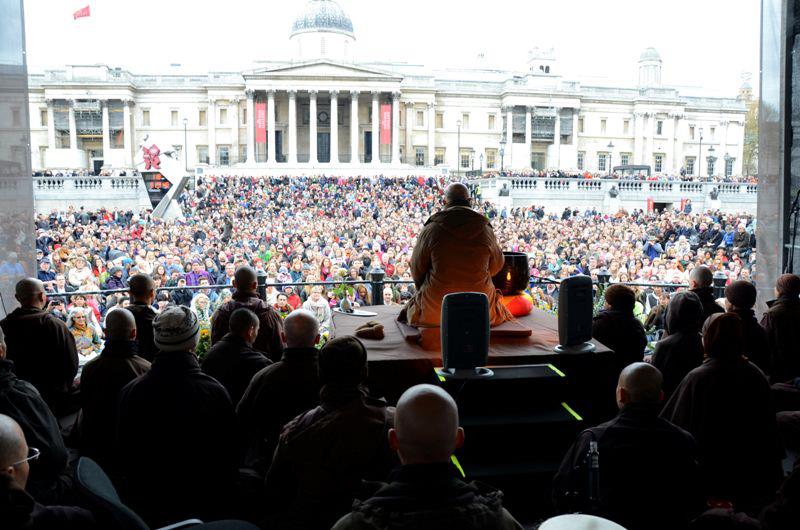
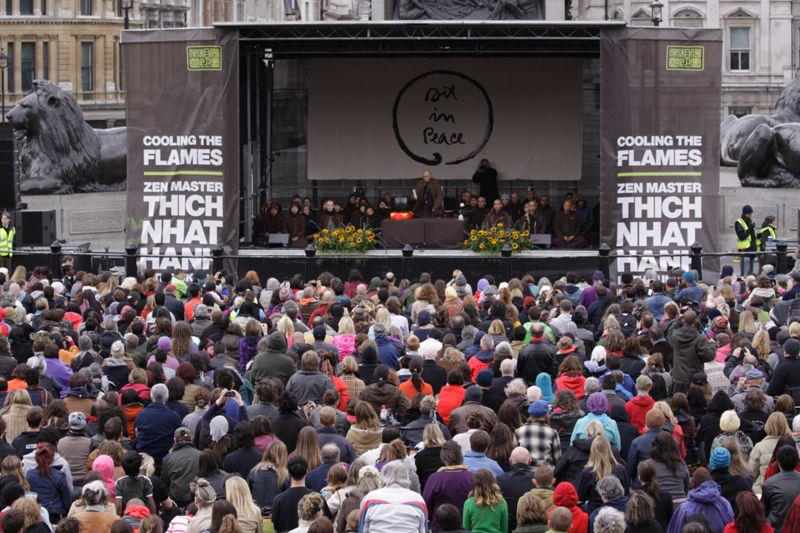
Thay arrived at 2:30 p.m. and was guided to the stage, which was beautifully decorated with banners and sunflowers, where fifty monastics were already seated. Elina continues: “As I motioned Thay towards the stage, he touched my elbow and said, ‘Hello, Elina,’ very softly, and I was really in awe and so moved, as though I was showing Thay the community we’d been cultivating, and that Thay being there was in some way a seal of approval. What I was most happy about was that I was able to join the guided meditation, and I even took out the earpiece of my walky-talky and thought, ‘This is it, this is my time, I’m not available, I am here.’ Only later did I discover that the stewards had spent the whole time trying to contact me because of some issue about parking Thay’s car in the square. But in the end it wasn’t a problem.”
The sound system carried Thay’s soft voice across the square to the thousands gathered in the open air. Not everyone at the very back and sides was able to hear Thay, but they were very much able to appreciate the energy of the whole event. The weather-blackened stone of Nelson’s Column ascended straight and high from behind the stage and further dramatised the sky, a continuous blanket of brooding clouds. We were grateful that the rain held off that afternoon.
The side walls of the stage could only partially shelter Thay from the gusty breeze that day. We knew he must be cold, and since he had already given a talk at the Royal Festival Hall in London to three thousand people two days before, we did not expect him to offer a long talk but perhaps some words to guide the meditation. However, despite the cold weather, Thay, looking out on a sea of people who were sitting on the ground in complete silence and breathing as one body, offered a deeply moving talk on how to apply the Four Mantras of Love:
Darling, I am here for you.
I know you are there, and I am very happy.
Darling, I know you are suffering. That is why I am here for you.
Darling, I am suffering. Please help.
Thay then led the Sangha in a powerful half-hour meditation, guiding us to experience our place on Mother Earth, to become aware of her love and care, and to offer her our gratitude. Finally he gave instruction as to the meaning and practice of the chant to Avalokiteshvara, inviting us first to be in touch with our own suffering and to offer compassion to ourselves; then to be in touch with the suffering of those close to us and to send them compassion; and finally, to extend our awareness and compassion to the suffering of the whole world.
It seemed, at that moment, there was a great coming together of the modern and the ancient, of different cultures and traditions, and of the suffering, hopes, and fears of different generations. Thay carries in his small frame a whole lineage of practitioners extending back to the Buddha’s time, and yet he is able to touch the present-day, globalised youth with his immense love, the most applicable spiritual teachings of our time, and the monastic Sangha he has nurtured over decades. It is this young generation who has been inspired to convene such a magical gathering through their Facebook pages. And Trafalgar Square itself, holding in its old stones and monuments a very English past, welcomed on this day an assembly very like the great assemblies of practitioners found in the ancient Mahayana texts.
By the time the monastics had finished chanting, Thay had been on stage some two hours. He left as quietly as he had come, and the people who had gathered naturally took time to connect with people close by before standing and peacefully heading home.
The Sangha Effect
Community had been created in these few hours; and it is reported that even in the crowded bookshops and cafes after the event, people were kind and loving with each other. Immediately after the event, Gaia, a steward, said, “Everyone I looked at had a smile on their face.” People felt so much a part of the event that they stayed behind to help dismantle and clean up, making the work incredibly light and joyful. Here in the heart of London, an epicentre of consumerism full of impatient traffic, emergency sirens, and the palpable buzz of dispersed and anxious people, something had changed. No one who was there will likely walk by Trafalgar Square again without recalling that, with Thay’s presence, a peace was generated here and offered to the city and the world by thousands of people.
People were sitting in peace not only in London. Through the various means of the Internet, “Sit in Peace” became an international event that included people from other cities in the UK and from other countries, such as the United States, Australia, Canada, Germany, Austria, Spain, Mexico, Israel/Palestine, and Vietnam.
One effect of Thay’s 2012 UK Tour, according to Elina Pen, is that it really brought the various London Sanghas and the Wake Up London Sangha together. She recalls, “We had to communicate a lot and meet up a lot, and it gave a real sense of purpose to what we were doing. We had lots of people who wanted to help but who hadn’t yet experienced our Wake-Up practice and the Plum Village Dharma doors, so we were very clear that all our meetings were rooted in the practice, and we invited everyone to come to the Sangha meetings. Those who ended up sticking with it and helping through the whole journey were those who were really involved in the practice with our Sangha. We really cultivated that feeling of connection to each other, and knowing we were each taking care of our part was a way to support the others doing their thing.”
Accounts from “Sit in Peace” organisers, stewards, filmmakers, attendees, and those who simply stumbled on the event paint a picture of a beautiful day. People of different cultures, religions, and ages, and from all walks of life came together and experienced transformation and healing, inspiration to practice, and immense gratitude for Thay, the monastics, Wake Up London, The Community of Interbeing UK, and all the conditions that allowed the event to take place. Special thanks goes to the “Sit in Peace” organising team and volunteers led by Elina Pen, London event coordinator Nick Kenrick, and UK tour organisers Philip Lynch, Angie Searle, and Theresa Payne.
Wake Up Sanghas are forming all over the world, and flash mob meditation sessions are proving very popular as a practice and as a means of bringing peaceful energy into our cities.The Occupy movement has invited Wake Up London to lead a meditation at St. Paul’s Cathedral to commemorate its one-year anniversary. Another Trafalgar Square sitting is planned for June 2013.
* Flash mobs publicised through the Internet began some years ago, sometimes to spectacular effect. Public invitations are sent out on Facebook and other electronic media for people to meet at a certain time and place to do something together. There have been flash mob dances, operas, and yoga. Elina Pen organised Wake Up London’s first flash mob meditation in Trafalgar Square in June 2011, and three hundred people came. Since then, many other flash mob sittings have occurred in London, and a community of sorts has developed among those who attend regularly. Some participants have started to attend Wake Up London Sangha meetings.
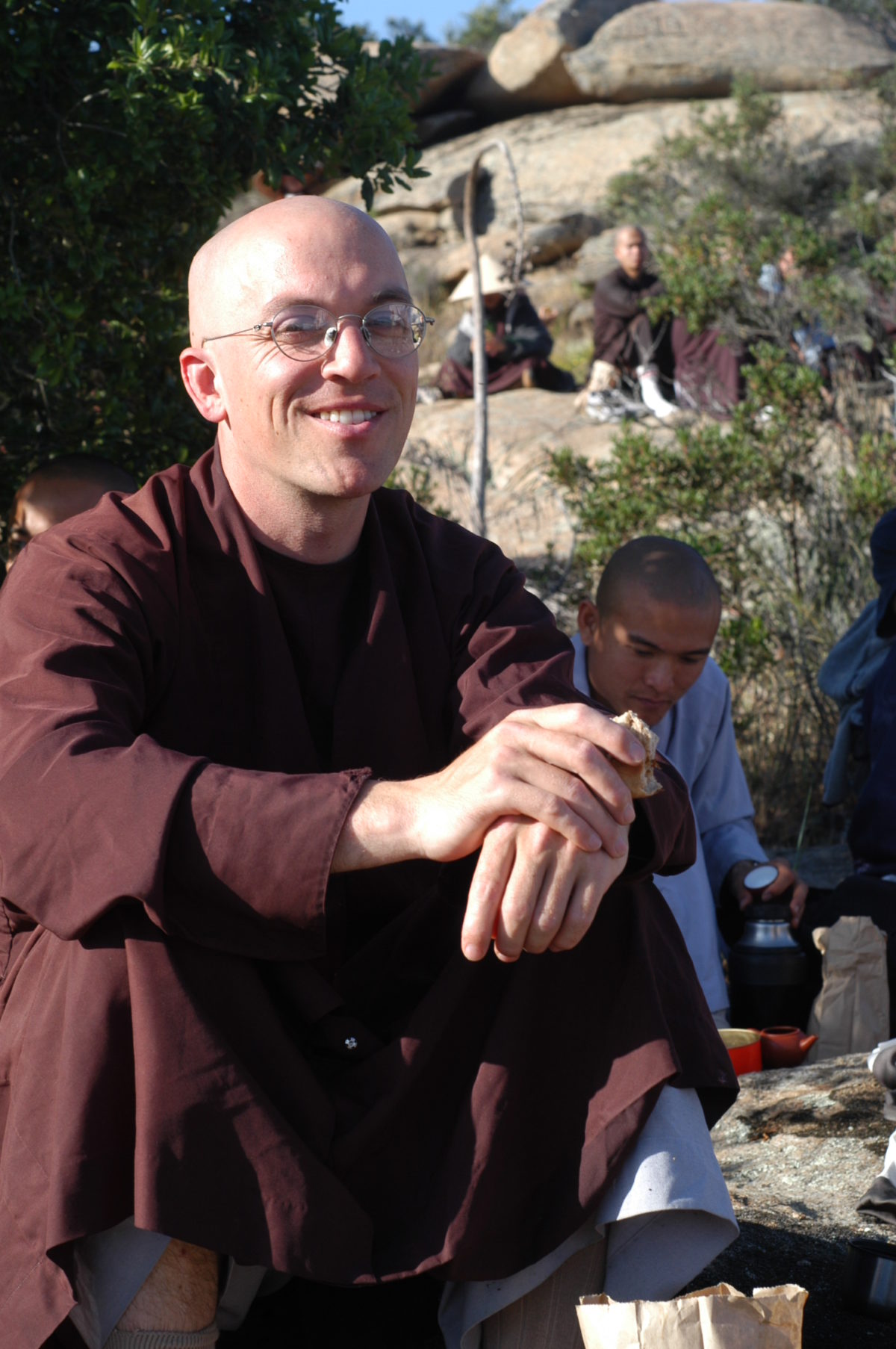
Brother Phap Lai is a Dharma teacher from the UK. He has been based in Plum Village since 2009. He helped organise Thay’s trips to the UK in 2010 and in 2012, including the “Sit in Peace” event at Trafalgar Square with Wake Up London, and the events in Ireland, including Thay’s intervention at Stormont, Northern Ireland.
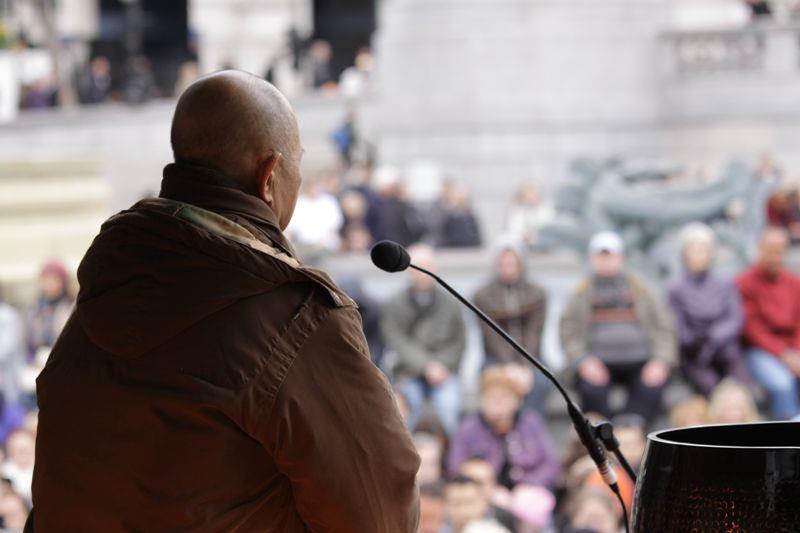
Quotes from “Sit in Peace” Attendees
"On the early morning of ‘Sit in Peace,’ I was finally able to complete a long letter to my departed partner. We had been together for eleven years (and some lifetimes), and the pain of the separation had me fall into a bereft silence for a year. During the event I was seated on the central steps, directly opposite Thay, the long distance rendered insignificant by his energetic presence. As Thay spoke, the many questions in my letter were answered: ‘Darling, I’m here for you…. I’m so happy…. Beloved, I know you are suffering…. Darling, I’m suffering, can you help?’ Tears were running down my face, and I knew this: We had had a blessed relationship for nine years because these lines were spoken most days. And our relationship ended because the last three years saw these words gradually vanish from our memories. May we remember more deeply on meeting again" —Marietta, steward
"I felt I could touch the heart of London, the grand stone buildings were alive with energy, and the people of England gathered there representing and manifesting a culture of deep spirituality." —Thay Phap Ung
"I grew up in a communist country where religion was suppressed. The stories I heard then as a child about Jesus, love, healing, and transformation were there just in front of me, in that present moment in Trafalgar Square." —Corduta, stewarding team leader
"I was moved to tears when the monks and nuns chanted ‘Namo Avalokiteshvara’ and it filled Trafalgar Square." —Shaun, attendee
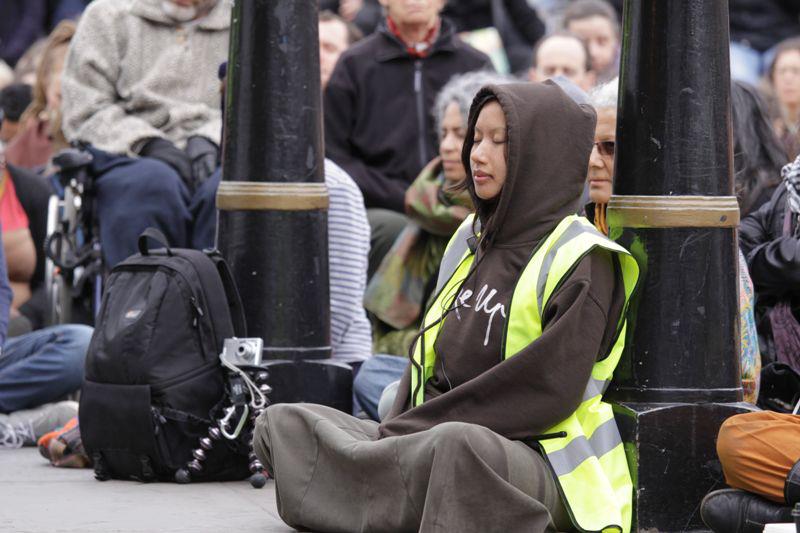
"It was an amazing feeling—all the noise of central London but so much inner peace. I had an enormous amount of energy pulsating through my heart that nearly took my breath away." —Lisa, attendee
"A distinguished-looking older gent who saw the event going on approached me to express disbelief that such a large crowd could be so quiet. He really seemed moved by the sight, even a little shaken. Another came to me and said, ‘I have been to many anti-war demonstrations in Trafalgar Square, but this is more powerful." —Jeremy Allam, OI member and steward
"This was my first time attending such a large group meditation and it really touched me. I feel meditation is going to have an important place in my life this year!" —Anita, attendee
"What made the ‘Sit in Peace’ so special for me was that this event was open to all. That thousands came together with Thay and the Sangha and they cradled London’s most public of spaces in peace and silence. It is an experience that is treasured by my family and myself." —Philip Lynch, UK tour core organiser
"It was a very spiritual day yesterday and I feel I loved everyone around me at that moment! My family and friends from Vietnam also meditated for two hours together with us" —A Vietnamese Londoner
"I’m so grateful that I was able to be there to Sit in Peace on Saturday. I have been ill all winter and have had a difficult time with my youngest son. This has made me very sad, but your kind, wise words spoke directly to my heart and I now feel so different. The chanting is still running around in my head, so healing and so beautiful. I feel changed on a deep level, and I will work very hard to keep and to share the precious gift I was given." —Niki, attendee
